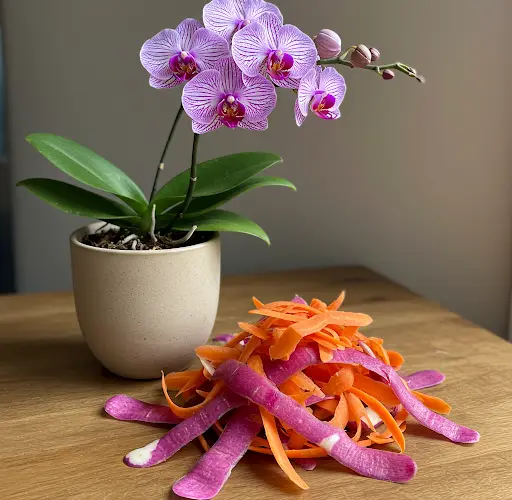To help you have many options for making your own fertilizer to care for orchids at home, I am sharing a method to create organic fertilizer using kitchen waste. This natural approach ensures your orchids receive essential nutrients while reducing environmental waste. Subscribe to the channel so you don’t miss any valuable tips and tricks for growing healthy, vibrant orchids.
The Power of Radish and Carrot Peels
When eating radishes, don’t rush to throw away the peel! Radish peels are rich in essential nutrients such as potassium, phosphorus, and nitrate. These components play a crucial role in providing energy for plants and promoting the growth of roots, leaves, and flowers. Similarly, carrot peels contain high amounts of potassium and phosphorus, making them excellent organic materials for plant nutrition.
Potassium is particularly beneficial for orchids because it helps regulate water and nutrient movement within the plant, strengthening its overall structure. Phosphorus plays a crucial role in root development, ensuring orchids have a strong foundation to absorb nutrients effectively. Nitrate, another important element, enhances the production of chlorophyll, which aids in photosynthesis and overall plant health.
Preparing the Organic Fertilizer
To create this organic fertilizer, I collected radish and carrot peels and soaked them in two liters of boiled water. Boiling water helps extract nutrients efficiently while breaking down organic compounds, making them easier for plants to absorb. After soaking, I allowed the mixture to cool before using it. Once the water was at room temperature, I filtered the solution to remove any solid residues, ensuring that only the nutrient-rich liquid remained.
Three Methods for Applying Fertilizer
Method 1: Root Application
Applying fertilizer directly to the roots is one of the most effective ways to provide nutrition to orchids. Orchids absorb the majority of their nutrients through their root system. To use this fertilizer for root application:
- Pour the liquid fertilizer directly into the orchid pot, ensuring the roots are well-covered.
- Repeat this process 1-2 times per month to maintain a steady nutrient supply.
- This method not only nourishes the plant but also improves soil structure by introducing organic matter, enhancing aeration, and increasing soil fertility.
By strengthening the root system, orchids can absorb nutrients more effectively, leading to healthier growth and more abundant blooms.
Method 2: Foliar Fertilization
Foliar fertilization involves spraying the fertilizer solution directly onto the leaves. This method is particularly useful for orchids as they can absorb nutrients through their leaves, supporting overall health and resilience.
To apply:
- Fill a spray bottle with the prepared fertilizer solution.
- Lightly mist the leaves on both the upper and lower surfaces.
- Repeat this process 1-2 times per month to keep the leaves strong and green.
One significant benefit of this method is improved hydration. Since radish and carrots contain a high water content, using their liquid extract helps maintain moisture levels in the orchid’s leaves. This is especially crucial during dry seasons when orchids are prone to dehydration.
Method 3: Cleaning and Nourishing the Leaves
Another effective way to use this fertilizer is by wiping the leaves. This method serves a dual purpose: it nourishes the plant and keeps the leaf surface clean, enhancing photosynthesis.
Steps for leaf cleaning:
- Dip a soft cloth or cotton pad into the fertilizer solution.
- Gently wipe the top and bottom of each leaf to remove dust and debris.
- This process helps leaves synthesize more chlorophyll, making them stronger and greener.
By keeping the leaves clean and well-nourished, orchids can maximize their ability to absorb sunlight and produce the energy required for growth.
Expected Results
After consistently applying this organic fertilizer for a few weeks, you can expect to see remarkable improvements in your orchid’s health and growth:
- Stronger, Greener Leaves – Enhanced chlorophyll production results in robust, vibrant foliage.
- Dense and Healthy Roots – The root system becomes stronger, allowing for better absorption of water and nutrients.
- Increased Flower Buds – Orchids develop multiple flower buds on a single plant, leading to abundant blooms.
- Drought Resistance – The natural potassium content in this fertilizer helps orchids retain moisture, preventing dehydration and flower drop.
- Long-Lasting Blooms – Flowers remain fresh and attached to the branch for extended periods, sometimes blooming continuously for months.
Conclusion
By using radish and carrot peels to create organic fertilizer, you can provide your orchids with essential nutrients while reducing kitchen waste. This natural, eco-friendly approach enhances soil health, strengthens plant growth, and promotes abundant flowering without relying on chemical fertilizers.
Incorporate this method into your orchid care routine, and watch your plants thrive! Remember to subscribe to the channel for more tips on growing beautiful orchids naturally. If you have any questions or experiences with organic fertilizers, feel free to share them in the comments section!



